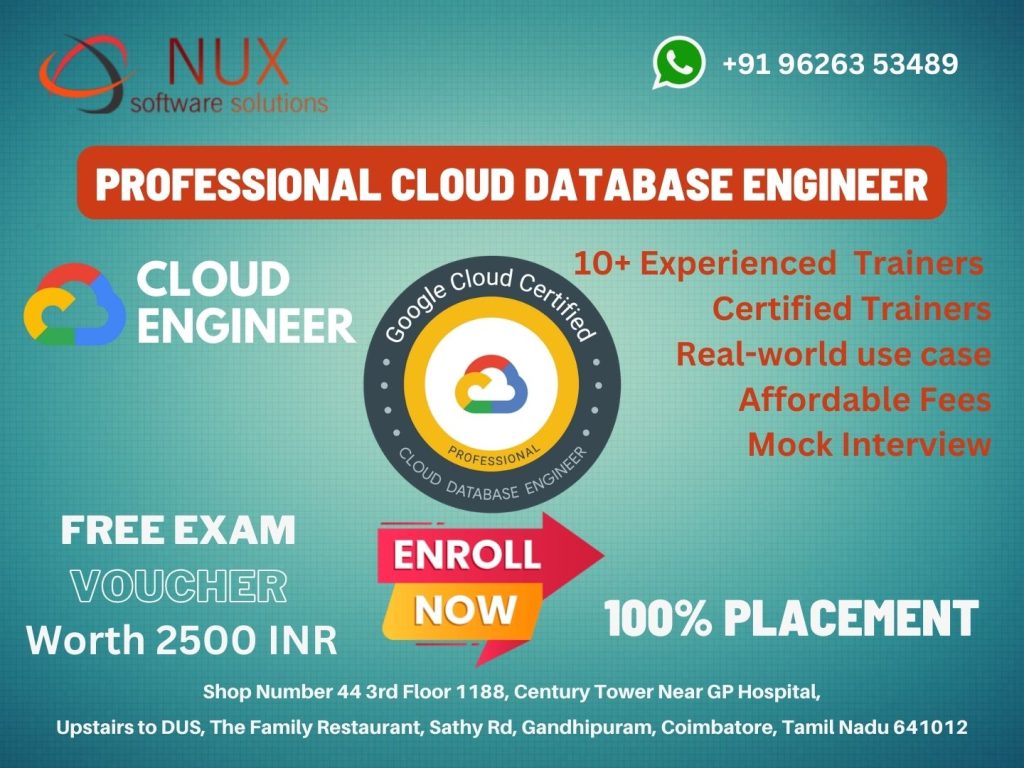Cloud Network Engineer Training and Certification in Coimbatore

Cloud Network Engineer Training – Advanced Cloud Networking & Security Mastery
Course Overview
The Cloud Network Engineer Training is a specialized, advanced-level program designed to equip learners with critical skills in cloud network architecture, multi-cloud networking solutions, network security implementation, and hybrid cloud connectivity. This course is ideal for individuals aiming to become certified cloud network engineers or senior network architects managing complex enterprise cloud network infrastructures across multiple platforms.
Offered by Linux Training Center, Coimbatore, this program covers advanced networking concepts across AWS VPC, Azure Virtual Networks, Google Cloud VPC, and hybrid connectivity solutions while providing extensive hands-on experience with network design, security policies, load balancing, and network automation, ensuring students gain both architectural expertise and practical implementation skills required for enterprise-level cloud networking roles.
Who Should Enroll?
- Network engineers transitioning to cloud networking roles
- System administrators seeking cloud network specialization
- Cloud architects wanting to master multi-cloud networking
- IT professionals pursuing advanced cloud networking certifications
- Network security specialists moving to cloud environments
- Infrastructure engineers planning hybrid cloud implementations
Why This Course Stands Out
- Comprehensive multi-cloud networking coverage (AWS, Azure, GCP)
- Advanced network security, firewall rules, and VPN implementations
- Real-world hybrid cloud connectivity and network migration projects
- Enterprise-grade load balancing, traffic management, and optimization
- Hands-on experience with network automation and Infrastructure as Code
- Industry best practices for network monitoring, troubleshooting, and performance tuning
- Preparation for advanced cloud networking certification paths
Career Roles You Can Pursue
- Cloud Network Engineer
- Senior Network Architect
- Cloud Infrastructure Architect (Networking Focus)
- Network Security Engineer
- Hybrid Cloud Specialist
- Site Reliability Engineer (Network Focus)
- Cloud Connectivity Specialist
- Network DevOps Engineer
Why Choose Linux Training Center, Coimbatore?
- Expert instructors with advanced cloud networking certifications and enterprise experience
- Multi-cloud lab environment with dedicated networking sandbox access
- Flexible training schedules: weekday, weekend, and intensive bootcamp options
- Real-world projects covering VPC design, hybrid connectivity, and security implementation
- Industry-standard networking tools and cloud platform access for hands-on practice
- Advanced troubleshooting scenarios, performance optimization labs, and certification prep
- Placement assistance with top cloud consulting firms and enterprise IT companies
- Ongoing technical support and professional networking community access
Elevate your networking career with specialized cloud networking expertise. This advanced training prepares you for high-demand, high-salary network engineering roles in the multi-cloud enterprise landscape.
Cloud Network Engineer Syllabus
Modules
Chapter 1.
1.0 Designing, planning, and prototyping a GCP network
1.1 Designing the overall network architecture. Considerations include:
Failover and disaster recovery strategy, Options for high availability, DNS strategy (e.g., on-premises, Cloud DNS, GSLB), Meeting business requirements, Choosing the appropriate load balancing options, Optimizing for latency (e.g., MTU size, caches, CDN), Understanding how quotas are applied per project and per VPC, Hybrid connectivity (e.g., Google private access for hybrid connectivity), Container networking, IAM and security, SaaS, PaaS, and IaaS services, Microsegmentation for security purposes (e.g., using metadata, tags)
1.2 Designing a Virtual Private Cloud (VPC). Considerations include:
CIDR range for subnets, IP addressing (e.g., static, ephemeral, private), Standalone or shared, Multiple vs. single, Multi-zone and multi-region, Peering, Firewall (e.g., service account-based, tag-based), Routes, Differences between Google Cloud Networking and other cloud platforms
1.3 Designing a hybrid network. Considerations include:
Using interconnect (e.g., dedicated vs. partner), Peering options (e.g., direct vs. carrier), IPsec VPN, Cloud Router, Failover and disaster recovery strategy (e.g., building high availability with BGP using cloud router), Shared vs. standalone VPC interconnect access, Cross-organizational access, Bandwidth
1.4 Designing a container IP addressing plan for Google Kubernetes Engine
Chapter 2.
2.0 Implementing a GCP Virtual Private Cloud (VPC)
2.1 Configuring VPCs. Considerations include:
Configuring GCP VPC resources (CIDR range, subnets, firewall rules, etc.), Configuring VPC peering, Creating a shared VPC and explaining how to share subnets with other projects, Configuring API access (private, public, NAT GW, proxy), Configuring VPC flow logs
2.2 Configuring routing. Tasks include:
Configuring internal static/dynamic routing, Configuring routing policies using tags and priority, Configuring NAT (e.g., Cloud NAT, instance-based NAT)
2.3 Configuring and maintaining Google Kubernetes Engine clusters. Considerations include:
VPC-native clusters using alias IPs, Clusters with shared VPC, Private clusters, Cluster network policy, Adding authorized networks for cluster master access
2.4 Configuring and managing firewall rules. Considerations include:
Target network tags and service accounts, Priority, Network protocols, Ingress and egress rules, Firewall logs
Chapter3.
3.0 Configuring network services
3.1 Configuring load balancing. Considerations include:
Creating backend services, Firewall and security rules, HTTP(S) load balancer: including changing URL maps, backend groups, health checks, CDN, and SSL certs, TCP and SSL proxy load balancers, Network load balancer, Internal load balancer, Session affinity, Capacity scaling
3.2 Configuring Cloud CDN. Considerations include:
Enabling and disabling Cloud CDN, Using cache keys, Cache invalidation, Signed URLs
3.3 Configuring and maintaining Cloud DNS. Considerations include:
Managing zones and records, Migrating to Cloud DNS, DNS Security (DNSSEC), Global serving with Anycast, Cloud DNS, Internal DNS, Integrating on-premises DNS with GCP
3.4 Enabling other network services. Considerations include:
Health checks for your instance groups, Canary (A/B) releases, Distributing backend instances using regional managed instance groups, Enabling private API access
Chapter 4.
4.0 Implementing hybrid interconnectivity
4.1 Configuring interconnect. Considerations include:
Partner (e.g., layer 2 vs. layer 3 connectivity), Virtualizing using VLAN attachments, Bulk storage uploads
4.2 Configuring a site-to-site IPsec VPN (e.g., route-based, policy-based, dynamic or static routing).
4.3 Configuring Cloud Router for reliability.
Chapter 5.
5.0 Implementing network security
5.1 Configuring identity and access management (IAM). Tasks include:
Viewing account IAM assignments, Assigning IAM roles to accounts or Google Groups, Defining custom IAM roles, Using pre-defined IAM roles (e.g., network admin, network viewer, network user)
5.2 Configuring Cloud Armor policies. Considerations include:
IP-based access control
5.3 Configuring third-party device insertion into VPC using multi-nic (NGFW)
5.4 Managing keys for SSH access
Chapter6.
6.0 Managing and monitoring network operations
6.1 Logging and monitoring with Stackdriver or GCP Console
6.2 Managing and maintaining security. Considerations include:
Firewalls (e.g., cloud-based, private), Diagnosing and resolving IAM issues (shared VPC, security/network admin)
6.3 Maintaining and troubleshooting connectivity issues. Considerations include:
Identifying traffic flow topology (e.g., load balancers, SSL offload, network endpoint groups), Draining and redirecting traffic flows, Cross-connect handoff for interconnect, Monitoring ingress and egress traffic using flow logs, Monitoring firewall logs, Managing and troubleshooting VPNs, Troubleshooting Cloud Router BGP peering issues
6.4 Monitoring, maintaining, and troubleshooting latency and traffic flow. Considerations include:
Network throughput and latency testing, Routing issues, Tracing traffic flow
Chapter 7.
7.0 Optimizing network resources
7.1 Optimizing traffic flow. Considerations include:
Load balancer and CDN location, Global vs. regional dynamic routing, Expanding subnet CIDR ranges in service, Accommodating workload increases (e.g., autoscaling vs. manual scaling)
7.2 Optimizing for cost and efficiency. Considerations include:
Cost optimization (Network Service Tiers, Cloud CDN, autoscaler [max instances]), Automation, VPN vs. interconnect, Bandwidth utilization (e.g., kernel sys tuning parameters)



